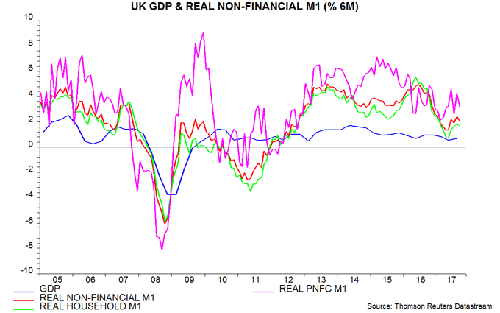
Janus Henderson: UK money trends signalling stable outlook
Monetary trends in the UK point to moderate but stable economic growth. The MPC-decision in August 2016 to ease the policy in the context of the strong money supply growth was wrong. The expected increase in bank rate is a partial reversal of this error. A market assessment from Simon Ward, Chief Economist at Janus Henderson Investors.
06.11.2017 | 09:27 Uhr
 UK monetary trends suggest modest but stable economic growth. Six-month growth of real narrow money – as measured by non-financial M1 deflated by consumer prices (seasonally adjusted) – has recovered since April 2017 but remains lower than over 2013-16. Real broad money trends are similarly subdued – see first chart*.
UK monetary trends suggest modest but stable economic growth. Six-month growth of real narrow money – as measured by non-financial M1 deflated by consumer prices (seasonally adjusted) – has recovered since April 2017 but remains lower than over 2013-16. Real broad money trends are similarly subdued – see first chart*.

Corporate narrow money developments are of particular interest at present: any Brexit-related cut-back in investment or shift of activity overseas should be signalled by a slowdown or contraction in real M1 holdings of private non-financial corporations (PNFCs). Growth, so far, is holding steady – second chart.

Some analysts have expressed alarm about weak household broad money trends: annual growth in household M4 fell from 6.8% to 2.9% between September 2016 and September 2017. A significant portion of this decline, however, reflects households switching out of bank and building society time deposits (including retail bonds) into investment funds and National Savings products. Retail sales of investment funds and inflows to National Savings totalled an estimated £38 billion in the 12 months to September, equivalent to 2.8% of household M4, compared with £10 billion or 0.8% in the prior 12 months.
The six-month rate of change of household real M1 – a better guide to consumer spending intentions – fell sharply in late 2016 / early 2017 but has remained positive and has recovered modestly from an April low. Household real M1 contracted ahead of consumer spending weakness in 2010-11.
The MPC was wrong to ease policy in August 2016 against a backdrop of then-strong monetary growth. Tomorrow’s expected Bank rate increase represents a partial reversal of that mistake: other elements of the easing package (i.e. the higher stock of QE and the still-expanding term funding scheme) remain in place. Current monetary trends suggest that the MPC should be cautious about signalling further rate hikes.
*Non-financial = held by households and private non-financial corporations. The M4+ measure shown in the chart includes foreign currency deposits and National Savings.



Diesen Beitrag teilen: